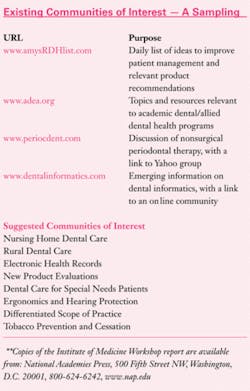Coming Together
How a 'Somebody' can make a difference
by Cindy Quinn, RDH, BS
Communities of interest (COI). Associations. Special interest groups (SIG). Alliances. Wikis. Collaborative partnerships. Unions. All of these represent groups of people that share a common interest. Some are united, focused, and willing to work as a group to support their cause, while others simply cluster. Throughout history, pivotal people have rallied these groups to shape the future. Take Gloria Steinem, for example, the leader for women's rights in the workplace in the 1970s. Ms. Steinem, an American feminist, journalist, and activist, helped found the National Women's Political Caucus and the Coalition of Labor Union Women. She campaigned for social reforms that promoted equality, and she helped break the stereotype that women can only tend the home. Like women, dental hygiene needs groups and spokespeople to break the stereotype that hygienists merely clean teeth and teach home care. So how does the profession break the current stereotype? We must change how we SEE a situation, rather than how we LOOK at a situation. We must see the opportunity for unity and change, rather than look at problems one person cannot fix alone.
To paraphrase an account from the book titled “The Story of Gloria Steinem,” by Elizabeth Wheaton, Gloria explains an encounter she had while waiting at the Plaza Hotel. She points out how the correct glimpse at a situation allows one an appropriate reaction. Gloria had been invited to interview an actor over tea, and after a long wait in the lobby she was approached by a hotel official who loudly announced, “Unescorted ladies are absolutely not allowed” in the lobby. When she tried to explain, the manager took her by the arm and led her out. In the exact same situation several weeks later, she saw the hotel manager again. By then, she had “glimpsed the world as if women mattered” and told the manager that the hotel was a public place where she had a legal right to be. She asked why he did not also banish “unescorted men” (pages 54–55). That required a new attitude about social norms and restrictions. Think about what might happen if hygienists glimpsed our world as if we mattered, rather than merely looked at the situation.
A united attitude creates synergy to accomplish a bigger vision, in our case, growth of the dental hygiene profession. This is not a new idea. According to the American Dental Hygienists' Association (ADHA) Web site, a group of hygiene leaders gathered in 2002 to discuss the future of dental hygiene with the association and wrote draft reports in six subcommittees. This generated a 2005 report called “Dental Hygiene: Focus on Advancing the Profession.”
It states: “As each subcommittee developed its report, several themes emerged: Hygienists must develop professional socialization skills, there must be greater networking among hygienists and increased collaboration within and across specialties, and there must be increased collaboration with policymakers and the public to ensure that hygienists' concerns are heard and the oral health needs of the public are met.”
How does a group of professionals, scattered around the country, become united in their efforts? Read on, but only after making a personal commitment to some form of action for the advancement of dental hygiene.
There is no room for “Somebody should” statements anymore.
Look in the mirror and meet Somebody.
See the utility in electronic communication
In marketing products, either the push–through or pull–through approach is used to attain product acceptance and adoption. Dental hygiene has historically used the push–through approach. The profession has pushed for changes in the practice acts, autonomy, and fair labor practices against very large organizations that move slowly and encourage the status quo, citing patient safety and adequate training, which is their job.
However, it is time for pull–through strategies meant to entice people to embrace the value of oral health expertise. With electronic communication and organized online groups of like–minded professionals, hygienists can affect change. To pull through an idea, one needs accurate information rather than emotional generalizations and conjecture.
There are two ways to get it — researching on–site at a nearby dental school library, or locating peer–reviewed materials on Web sites. Evidence–based material is crucial because it is peer–reviewed with citations. Armed with data, groups can work on issues that need change, thereby educating the profession.
Which issues are the most important to a majority of hygienists? No one knows yet, but the sheer volume of active members in a COI, their level of proposed initiatives, and their internal organization will make that clear. Initially, each COI starts with a purpose and a summary of the present realities.
This exercise calls attention to significant gaps in the path to progress. If the group focuses on these gaps, they can develop formal strategies to overcome them. If they don't focus or begin to bicker, the group will dissolve. Strategies lead to action plans, and someone like Gloria should be the spokesperson. Membership is not just a name on a roster. Committed members make time for their COI each week. A sampling of existing communities of interest, as well as ideas for potential COIs, is listed in a sidebar.
See the need for action, not reaction
Please pause to honor the Golden Rule. There is no room for disrespect, manipulating, or assigning blame. Everyone has a story of inappropriate scheduling, incomplete treatment, or misguided motivations. This just bogs down progress and is counterproductive. History cannot change past perils, but it can prove the foundation for future change. Courteous discussion and well–substantiated information, with the patients' best interests as the priority, are the keys to progress. If necessary, keep the Golden Rule taped to the inside of your face shield or instrument drawer.
See the need to support the cause
Committed professionals must place priority on evidence–based continuing education courses. Why? One can only take effective action with substantiated evidence. They risk wasted efforts when using anecdotal statements. Vendors who generously support programs must be required to provide at least two peer–reviewed, published research studies to back up each claim. Over time, this focus on evidence–based research will raise the bar on dental hygiene decision– making and minimize the use of anecdotal statements.
However, research is expensive. To counterbalance these costs, hygienists should support manufacturers in their area. Focus groups, or constructive comments from dental practices, are valuable to management and regarded much more than a casual comment passed on by a sales representative.
As a corollary, dental hygiene program alumni should support their schools in the development of online coursework and new technology purchases. Donations of all types are useful.
Even the samples and materials received at dental meetings are perfect for student trial and dispensing. Also, those professionals with a passion for sharing their expertise should coordinate a continuing education course at their alma mater, present it, and donate the profits back into the program. Finally, one needs to encourage current students to “job shadow,” with an emphasis on objectivity so they can glean from real–life experiences.
The combination of organized group discussion, professional respect, evidence–based direction, and decisive action will change the way hygienists see the situation. It will bring about unity and change aimed at advancing the profession. Remember that the ultimate act of complacency is failing to embrace the future.
See the curse of complacency
As long as this profession adheres to the disease of complacency, dental hygienists will look like victims, plagued by animosity from others in the profession. The line will become blurred between professionally trained competence and a clinician who wants more responsibilities. There will be no clear–cut path for career advancement, and the public will continue to regard most dental hygiene professionals as “tooth cleaners.”
Rather than adequately treat disease, hygienists may succumb to the insurance industry's reimbursement mandates because patients want only covered procedures. Highlights from the February 2009 Institute of Medicine Workshop**, titled “The U.S. Oral Workforce in the Coming Decade,” provide a telling summary:
“The current oral health workforce fails to meet the needs of many segments of the U.S. population. Challenges include a lack of coordination and integration among oral health, public health, and medical health care systems; misaligned payment and education systems that focus on the treatment of disease rather than prevention; the lack of a robust evidence base for many dental procedures and workforce models; and regulatory barriers that prevent the exploration of alternative models of care.”
Scared enough to take action? Commit to be the Somebody who will advance this profession. To quote Gloria Steinem, “The first problem for all of us, men and women, is not to learn, but to unlearn.” Get involved. Change how dental hygienists see challenges and overcome obstacles, as Gloria did over three decades ago. Become a Somebody.
About the Author
Cindy Quinn is the first year clinic coordinator at a new dental hygiene program in Mesa, AZ. Those with an interest in starting a Community of Interest as a “dental hygiene Somebody” should email her at [email protected].


